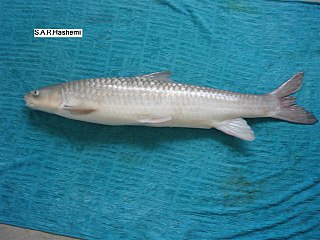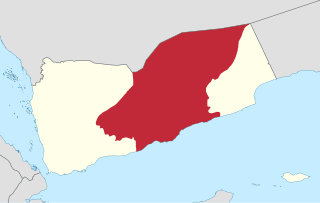
The Jordan River or River Jordan, also known as Nahr Al-Sharieat, is a 251-kilometre-long (156 mi) endorheic river in the Levant that flows roughly north to south through the Sea of Galilee and drains to the Dead Sea. The river passes by or through Jordan, Syria, Israel, and the Palestinian territories.

Hadhramaut is a geographic region in the southern part of the Arabian Peninsula which includes the Yemeni governorates of Hadhramaut, Shabwa and al-Mahra, as well as Aden, Abyan and Lahij. Some sources also include Dhofar Governorate, in southwestern Oman, and Shaurah, in Najran Province, in southern Saudi Arabia. The name is of ancient origin, and is reflected in the name of the Yemeni Governorate of Hadhramaut. The people of Hadhramaut are called the Hadharem. They formerly spoke Hadramautic, an old South Arabian language, but they now predominantly speak Hadhrami Arabic.

Seiyun is a city in the region and Governorate of Hadhramaut in Yemen. It is located in the middle of the Hadhramaut Valley, about 360 km from Mukalla, the capital of Mukalla District and the largest city in the area, via western route. It is 12 km from Shibam and 35 km from Tarim, the other large cities in the valley.

Barbus is a genus of ray-finned fish in the family Cyprinidae. The type species of Barbus is the common barbel, first described as Cyprinus barbus and now named Barbus barbus. Barbus is the namesake genus of the subfamily Barbinae, but given their relationships, that taxon is better included in the Cyprininae at least for the largest part.

Yemeni Arabic is a cluster of varieties of Arabic spoken in Yemen and southwestern Saudi Arabia. It is generally considered a very conservative dialect cluster, having many classical features not found across most of the Arabic-speaking world.

Marsa Alam is a tourist town in south-eastern Egypt, located on the western shore of the Red Sea. It is described as a "popular" tourist destination. Marsa Alam is a relatively recently-built town; its development began in 1995 through the investments of the Kuwaiti Al-Kharafi Group, which established the town and its initial facilities, resorts and infrastructure. Its growth was accelerated by the opening of Marsa Alam International Airport in 2003. Due to its crystal clear water and its white sandy beaches, it is also known as the "Egyptian Maldives."

The shabout is a species of cyprinid fish also called in English, Persian or Arabic by the alternate common names shirbot and variations shabut, shabboot or shabbout, and in local languages by several other common names. It is a large freshwater carp found in Western Asia, where it inhabits the Tigris–Euphrates Basin, as well as Iranian rivers that flow into the Persian Gulf.

Wādī al-Ḥītān is a paleontological site in the Faiyum Governorate of Egypt, some 150 kilometres (93 mi) south-west of Cairo. It was designated a UNESCO World Heritage Site in July 2005 for its hundreds of fossils of some of the earliest forms of whale, the archaeoceti. The site reveals evidence for the explanation of one of the greatest mysteries of the evolution of whales: the emergence of the whale as an ocean-going mammal from a previous life as a land-based animal.

Hadhrami Arabic, or Ḥaḍrami Arabic (ḤA), is a variety of Arabic spoken by the Hadharem (Ḥaḍārem) living in the region of Hadhramaut in southeastern Yemen, with a small number of speakers found in Kenya.

Garra barreimiae, the Oman garra, is a species of ray-finned fish in the family Cyprinidae. It is found in the mountains of northern Oman and in the United Arab Emirates. Most populations inhabit wadis, streams, pools and springs, but one population which lives in a cave system, is known as Omani blind cave fish, and has lost its sight and pigmentation. The only other cave fish in the Arabian Peninsula is the Tawi Atair garra, but it has normal eyes.
Hadhrami or Hadrami may refer to:

Wadi Wurayah is a 12,700-hectare (31,000-acre) wadi between the towns of Masafi, Khor Fakkan, and Bidiyah in the United Arab Emirates. It has been designated as Ramsar Wetland of International Importance. The lush canyon in the area was named after the tall marsh plant known as ‘warrah’, that flourishes in its wetlands, while the word ‘wadi’ is the Arabic term for valley.

Wadi Harrana is a seasonal stream (wadi) in the eastern Jordanian Badia, about sixty kilometers southeast of the city of Amman. It runs eastwards from the edge of the Jordanian Highlands to the Azraq oasis.

The Hadharem are an Arabic-speaking ethnographic group indigenous to the Hadhramaut region in the Arabian Peninsula, which is part of modern-day Yemen. The spoken language of the Hadharem is Hadhrami Arabic. Among the two million inhabitants of Hadhramaut, there are about 1,300 distinct tribes.
The Al Kathiri also known as Alkaseri is a royal family that has had strong influence in the south of the Arabian Peninsula. It is one of the largest tribes of Banu Hamdan Hadramawt in eastern Yemen and Oman, with populations in Saudi Arabia, Qatar, United Arab Emirates, and East African countries such as Somalia and Kenya and Tanzania as well as Iran mainly concentrated in the most Arabic populated province of the country Khuzestan. However, there are two tribes of Al Kathiri one is Banu Hamdan and one is Banu Lam tribe, which is descendant from Tayy tribe, is located in Najd - northern Saudi Arabia - Kuwait - Iraq, and branched to Al Kathran (الكثران), Al Mughira (المغيرة), Al Fadhuol (الفظول) and Al Dhafeer (الظفير).

Arabibarbus is a genus of Cyprinidae. They are medium-small to very large freshwater carps found in the Western Asia.
Arabibarbus arabicus is a species of ray-finned fish in the genus Arabibarbus which is found in wadis in the south western Arabian Peninsula.

Wadi El Gemal National Park is a national park in Egypt. It is 7,450 square kilometres (2,880 sq mi) in size, including 4,770 square kilometres (1,840 sq mi) of land and 2,100 square kilometres (810 sq mi) of marine space.

The Bou Sellam River is a river of the Maghreb region in Algeria, in Bordj Bou Arréridj Province. The river flows through the Bou Sellam Valley, and is obstructed by the Ain Zada Dam.
The Battle of Al Masini Valley, code named Operation Al Faisal by the Saudi-led coalition, was an operation conducted by the UAE-backed Hadhrami Elite Force with backing from the UAE Armed Forces to clear the Al-Qaeda in the Arabian Peninsula (AQAP) controlled stronghold of Al-Masini Valley in central Hadhramaut governorate.














